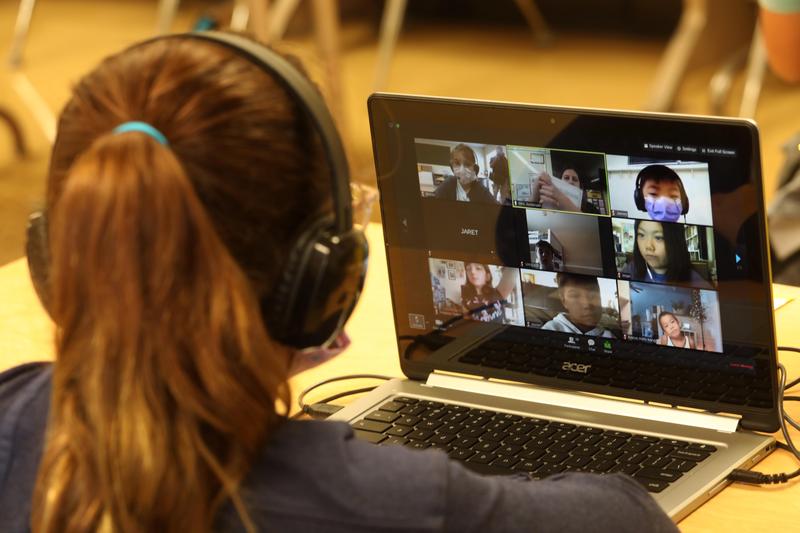After five straight years of gradual improvement, standardized test scores declined significantly last year for many California students, most of whom spent 2020-21 in distance learning. Gaps in achievement between Blacks and Hispanics and their white and Asian peers, already wide before the pandemic, expanded in math and English language arts.
State education officials, however, cautioned that the number of students who took the tests last year was much smaller than in earlier years. Before the pandemic, districts were required to administer Smarter Balanced tests each spring. The tests were suspended in the spring of 2020 and last year the tests were optional. Only 744,000 of 3.1 million students in grades three to eight and 11 took the Smarter Balanced tests last spring. While less than a quarter of the total, the scores are a strong indication of how much students have fallen behind in learning during the pandemic.
Also reversing a decade-long trend, 4-year graduation rates fell by less than 1 percentage point, to 83.6%, although they fell sharply among Black students, by 4.3 percentage points, and Latino students by 1.6 percentage points, reflecting the disruption caused by Covid in communities of color. Graduation rates, however, increased among whites and Asians, rising to 94.1%.
The release Friday of Smarter Balanced assessment scores and other school data provides strong evidence that the pandemic has set back learning in core academic subjects, particularly among early elementary students, whom teachers said had the most difficulty adjusting to classes on Zoom.
The tests were administered throughout spring 2021 on computers to students who had spent most of the year learning remotely.
The scores are “depressing but also inevitable since California was among states that kept students in distance learning the longest,” said Arun Ramanathan, CEO of Pivot Learning, a nonprofit consulting organization that works with schools in California and other states on improving achievement. “Schools did not do a good job serving kids virtually and many kids stopped coming to school, especially in early grades” among low-income families without the resources to help their children.
“I could see this in my basement with my wife trying to teach kindergartners over Zoom to read,” said Ramanathan, who is married to a teacher.
Last year, districts had the option of taking Smarter Balanced or another local assessment aligned to the Common Core standards, and most chose the latter, including 16 of the 20 largest districts. This spring, students in all districts will resume taking Smarter Balanced tests, including a science assessment.
EdSource compared the test scores of the 3,063 district and charter schools that gave Smarter Balanced last year and two years earlier, in pre-pandemic 2018-19. The state suspended testing in 2019-20, because schools closed in response to the pandemic in March 2020, when testing was scheduled to begin.
In those schools that administered the tests last year, 48.9% of students met or exceeded standards in English language arts in 2021 — the equivalent of passing the test — down from 52.2% in 2019. In math, 33.6% met or exceeded standards, down from 38.2% in 2019.
But for Latino students, the drop was more severe: from 25.9%, who passed in 2019 to 20.2% last year in math and from 41.7% to 37.5% in English language arts.
Black students’ scores fell from 35.4% to 33% in English and from 19.1% to 17.4% in math.
White students’ scores declined from 64.1% to 60.7% in English and from 50.6% to 45.7% in math.
The pandemic and distance learning appear to have affected English learners’ progress in learning English as well. Close to 1 in 5 students in California public schools — about 1.1 million— are considered English learners. Schools are required by state and federal law to test students on their level of English proficiency, if they speak a language other than English at home. The test is given to English learners every year, until they achieve a high enough score to be considered fluent in English.
More English learners scored at lower levels of English proficiency last school year than they did two years earlier, and fewer tested at the higher levels. Schools faced many difficulties in testing students for English proficiency during distance learning. In 2018-19, 96% of enrolled English learners were tested, while in 2020-21, only 89% were tested.
The lower scores may be a result of both the conditions of testing and the quality of English language instruction during distance learning, said Magaly Lavadenz, a professor of English Learner research, and executive director of the Center for Equity for English Learners at Loyola Marymount University. Lavadenz said English Language Development instruction varied widely from district to district. “It suffered in many places,” Lavadenz said.
Also, she said, testing remotely at home in many instances, may have affected results. “It was very confusing for families, especially for young children. We know that the conditions for testing were not optimal, by any means,” Lavadenz said.
The California Department of Education cautioned against reading too much into the two-year comparison. Districts in a normal year are required to have a 95% participation rate, but that was suspended for last year’s test.
Absences may have been significant in some schools, and the 24% of students who took the test may not fully correspond to the state’s demographics. At the same time, the data may understate the decline in scores, because students who had poor internet connections and who were chronically absent last year may not have taken the test.
“The lower and uneven participation rates require that data interpretations regarding the 2020–21 assessment results be made with explicit caution, keeping in mind the specific context and conditions of the learning experience at that school and district,” the department warned in an interpretation guide to the results.
